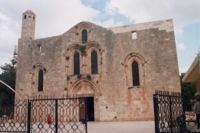Year consecrated mid-12th century | Status Museum | |
 | ||
Similar Chastel Rouge, Chastel Blanc, Margat, Syrian Coastal Mountain, Krak des Chevaliers | ||
Cathedral of Our Lady of Tortosa (Arabic: كاتدرائية طرطوس) was a Catholic cathedral in the city of Tartus, Syria, erected during the crusader-era 12th-century . It has been described by historians as "the best-preserved religious structure of the crusades".
According to a legend, the place corresponds to where Peter was ordained.
After capture by the Mamluks, the cathedral was turned into a mosque. Today, the building serves as the National Museum of Tartus.
History
The cathedral was erected on the place for previous Byzantine pilgrimages. It was built initially in Romanesque style and then gothic style during the 12th century.
From 1152 under mid-13th century, the Knights Templars governed the area. Since the town was repeatedly threatened by the Mamluks, the church building was fortified.
Tartus was allegedly the last holdings of the Knights Templars in the Near East. After capture, the cathedral was turned into a mosque. During the Ottoman period, the building was used as a stable. Today, the prior church building serves as the National Museum of Tartus.
